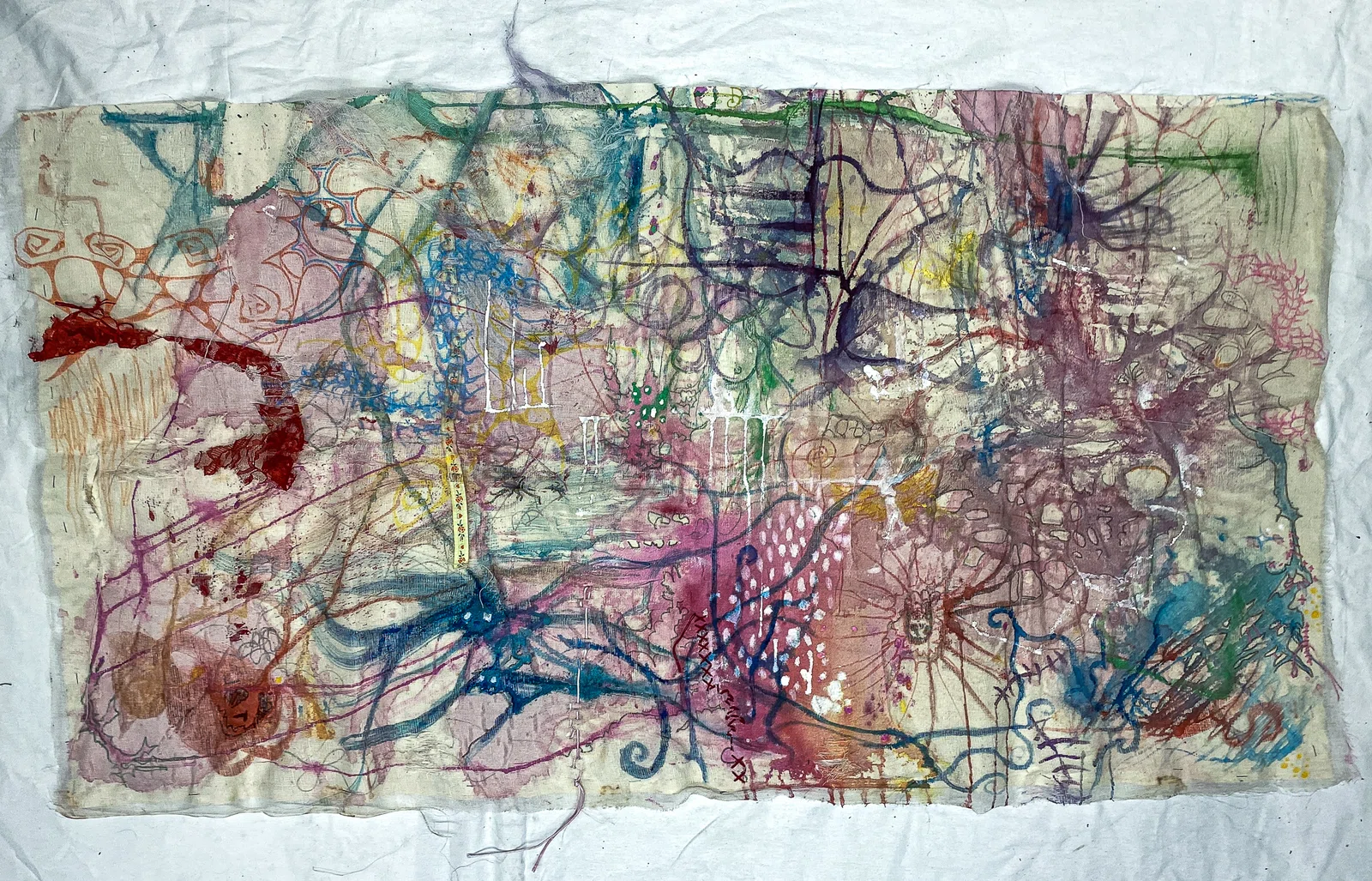







Drawing
Patrizia Galati
West Windsor Plainsboro High School South|West Windsor, New Jersey

Untitled|31 x 56 in.
Material(s): raw canvas, gauze, fabric scraps, water color, ink.
Process(es): pollack approach,distressed layer of gauze for paint to pass thru, spilling, flow of beta fish, mold.
Curatorial Note: a flow from the brain.


“A lot of my creative process is about getting messy, using my hands, building up my canvas, and then distressing and breaking it down, I use whipping spikey lines to create a rigidness which I juxtapose with muted colors and neutral tones. I like the action of distressing canvas and the skeletal, lace-like quality, using recycled and found objects as a memento mori or to give it a new meaning, tying knots and sewing things back over to build up layers and create unraveling texture, ultimately bringing together my roman catholic heritage and my high school experience as a very tactile learner.”
Student statement
Student
statement
Listen to the student statement
Read the transcript
One of the main things that has always attracted me to art is the very tactile quality of it all. Ever since I was young, I've always been a very hands-on tactile learner and just human being, and I tend to collect things. I'm very much an observer, and I like to experiment and see how things react or how different things around me and my environment or in nature may look and how I can reflect those into my art pieces. Art is a very like therapeutic outlet for me.

One of the main things that has always attracted me to art is the very tactile quality of it all. Ever since I was young, I've always been a very hands-on tactile learner and just human being, and I tend to collect things. I'm very much an observer, and I like to experiment and see how things react or how different things around me and my environment or in nature may look and how I can reflect those into my art pieces. Art is a very like therapeutic outlet for me.
I tend to use a lot of different mediums and experiment with them and see the different outcomes in composition. I don't really like to plan out my pieces too much because I tend to get really frustrated when my pieces don't necessarily turn out like my sketches, and that's always been something that I didn't like about the traditional tract in art is a lot of the times you need to like make your sketch before you make your painting. But the way that I've always interacted with art has just been very freely and playfully, and I like to just mix up all the things that intrigue me and what if I see patterns or textures or outcomes that I like I'll repeat those. I really like to sort of rip apart my canvases. I'm really drawn to raw canvas just because of the movement of it and the way it adheres to different mediums and like sinks in and creates these sort of spidery forms.
I feel as though that has really been very consistent in my process is the use of raw canvas. Also just building my canvases—like finding wood and different bits around to create the structure itself—sort of sculpting in a way. I feel like the ways I can use the materials I find around me to then present my canvas is something that has also been very interesting to me to explore—especially throughout my time like in AP Studio. I did a lot of distressing and weaving and collecting little bits that I find. Sort of like just found objects and compiling them into collage and you know, the repetition of prints and different mediums that I can just explore and just compile into one sort of piece and then take things that I like from one piece and combine them with things that I like in another piece. And just seeing how far I can really push my experimentation. I really like the use of like hard edges, like wood and rusty nails against like bright colors and like fluffy moss in nature and different, sort of like fibrous textures.
Uhm yeah, really just textiles as a whole and how textiles interact with mediums is something that has been very appealing to me, and like working with dyes and different mediums as a whole. And just sort of building up and then ripping everything away and breaking it away and, you know, like distressing my canvases is another really good way for me to sort of give them like areas where light can pass through. As a lot of my art I do like to present outside or make outside, so the way my art can interact with nature and sunlight is another thing that is very important to me. Um, like mold patterns, I'm very inspired by mold patterns and very mathematical things in nature—fractals, you know, all that sort of stuff.
So yeah.




Patrizia Galati
Teacher Statement
Teacher Statement
Nathan Leventhal
Working with Patrizia (Toots) Galati was a pleasure. They have one of the most developed senses of productive play that I have ever encountered. If there’s an artistic super-power, it would be centered on their love of media (both traditional and unconventional) and possibilities offered through processes that is virtually limitless. They are enamored of textures and fall in love with the little details that they just layer upon layer.

I give lots of leeway in interpreting assignments to invest students in the work on a very personal level. The AP class is really a group of independent studies that, in the best cases, become a team that supports/pushes each other. The students need to stop trying to be the artist they think they have to be and start being who they are. They are only competing with themselves. They need to focus on their strengths and avoid their weaknesses. The only real skill-building that is done is individually based on what the student wants to accomplish and what they need to know for that. They also keep open the idea of solving problems with alternatives that build on what they already know versus what’s “expected.”
Toots came naturally to this. They threw their work on the ground and trampled it. They left canvas in the rain for weeks to watch the developing fungus and mold patterns. They took a nosebleed and turned it onto a previous piece while investigating splatter patterns. While painting, they tip canvases and blow paint into new patterns. They balance constructive aspects with destructive elements too.
I try to encourage pushing work in new directions to give them approaches that include avoiding total predetermination of the outcome. I try to instill the idea that if their art always stops before it’s pushed too far, they’ll make a collection of really good art—but if they push it without fear of ruining it, then they can make some truly great works. Key to this approach is the idea that your art isn’t ruined unless you stop working on it, and sometimes the ruining is necessary for discovery and problem-solving that will create the truly spectacular.
It is also crucial to develop their analytic and written/verbal skills for expressing themselves. Both in their own work (where being able to express your thoughts and concepts helps you determine if your art is really doing what you want it to) and in looking at others’ (where you do not have to make every mistake yourself to learn, and your insights help people grow to become better themselves). There’s a steady rotation of group critiques, small-group mini-critiques, and weekly reflection/projection in their journals. The journal's role of investigation/reflection/recording is emphasized, and they are reviewed for usage rather than a specific approach. Everyone can use their journal differently as long as it’s authentic usage and not just filling in pages. They generally use their journals for their artist-hero research as well.
Patrizia was always willing to join in interpreting the works of others. This comes from developing a safe place for thought, but also grows as people like helping those that helped them. The more they grow in their ability to talk, the more they talk. Their work is not collected at critique either. They have time to respond and adjust after critiques. They can also revisit their work after grading to improve it, but there needs to be a significant effort and difference for re-grading.
Our school has a variety of spaces and support. Many teachers work with our students when interests cross curricular boundaries. This school community started because we were not afraid to ask for help, and you shouldn’t be surprised at how much people like to support enthusiastic students with their own knowledge to help them solve new problems. Our administration is all brand new as of a year ago, but they already continue the tradition of supporting the arts that have made our department a vital part of the school and are heavily involved in service to the school and other teachers.
In closing, push your students to their strengths, push them to try new things based on those strengths, push them to determine what really is important to them about art and art-making, learn what makes every student different and special, and then celebrate and direct it, make failure a step in the process of success, make them talk and write and reflect on their own and others’ work, get involved in the larger school community and take advantage of the advantages and strength it gives, and take a day now and again to have a shenanigans day to develop the room as a family. The best years are the ones where they become a unit that dissolves the normal expectations and groupings that they came with.
















